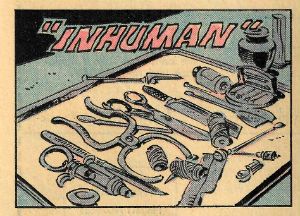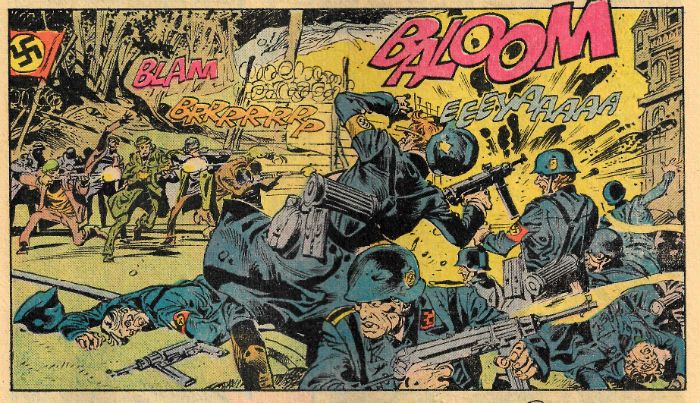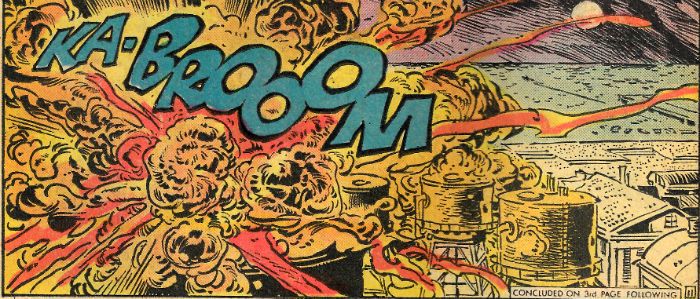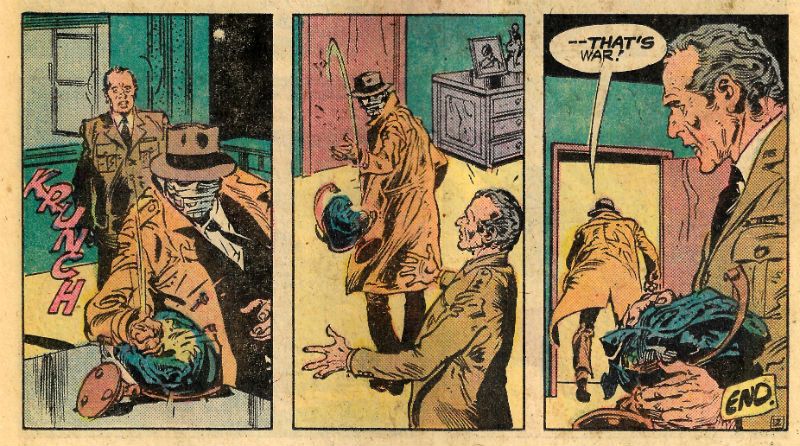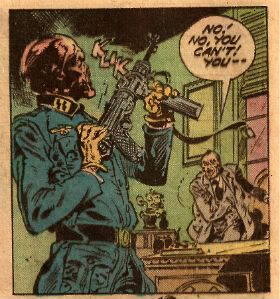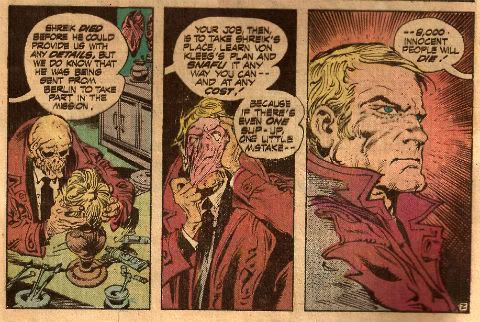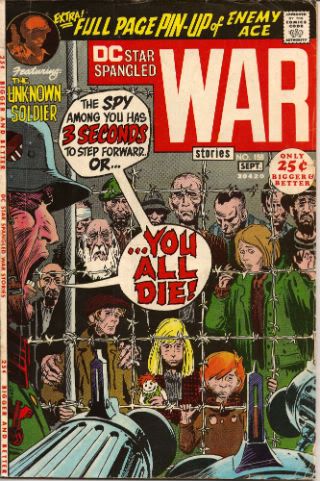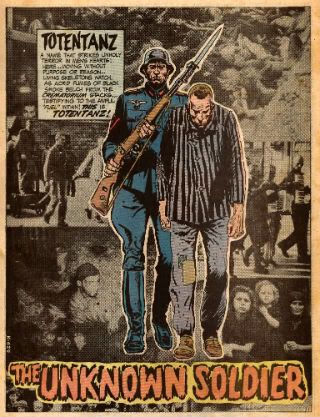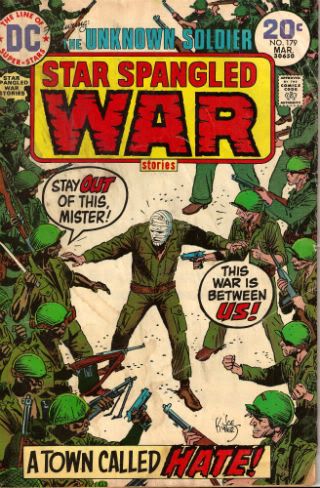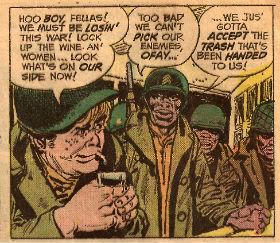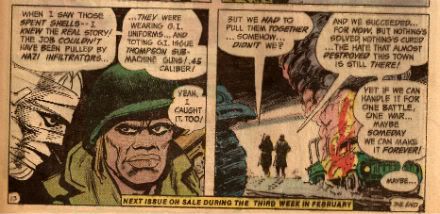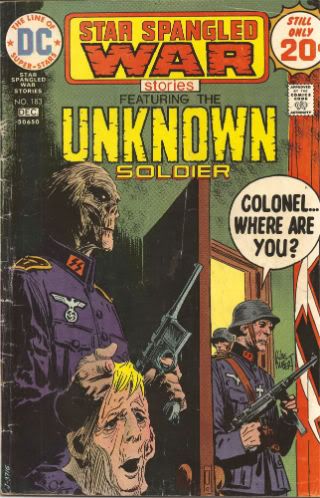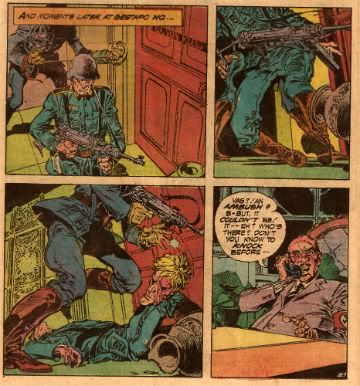“They're Rewriting History. But They Forgot About Me.” VIDEO GAMES! Sometimes I Think After Manic Miner It Was All Downhill.
/Geeze Louise, it's a regular content tailback you can see from space we got going on here. Below this is Brian "Two Shops" Hibbs' Shipping List and under that is Abhay Khosla's typically effervescent take on the TV pitch comic Fatale. Me, I let the side down and do a good impression of a middle aged man who doesn't understand what he is looking at or why it is doing those things. Yes! I played a video game and I didn't have to go to an Arcade to do it. It was in my own home. Food in pill form next. I'm tellin' ya! IT'S PEOPLE!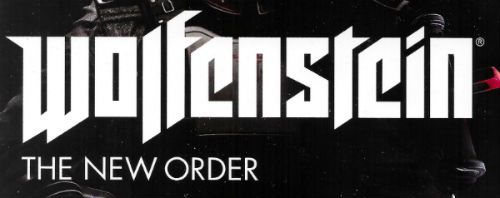 Oh, be warned; I have no idea how to get pictures off my XBox 360 so I just scanned in some images. What do you want, jam on it?
Anyway, this...
As age sets in I think it helps keep you fresh to find new things to fail at, so here’s my latest attempt to avoid staleness setting in. (Too late, John!) This one’s about a video game. Now, I am horrifically old (face wrinkled like a bat’s anus; side parted nasal hair) so some of the terms I’ll use might be a bit out of date (modem; joystick; decency; socialism) but hopefully I’ll make myself understood plainly enough. Hey now, hey now, now, put down your Rubik’s Cubes and let’s slap that cassette into the tape player, adjust the volume infinitesimally and bask in a high pitched shrieking (not unlike I imagine a mass slaughter of ghosts might sound) because this thing is LOADING….LOADING….shit…let’s try that again…LOADING….LOADING….hang on…LOADING…LOADING…LOADING…
Oh, be warned; I have no idea how to get pictures off my XBox 360 so I just scanned in some images. What do you want, jam on it?
Anyway, this...
As age sets in I think it helps keep you fresh to find new things to fail at, so here’s my latest attempt to avoid staleness setting in. (Too late, John!) This one’s about a video game. Now, I am horrifically old (face wrinkled like a bat’s anus; side parted nasal hair) so some of the terms I’ll use might be a bit out of date (modem; joystick; decency; socialism) but hopefully I’ll make myself understood plainly enough. Hey now, hey now, now, put down your Rubik’s Cubes and let’s slap that cassette into the tape player, adjust the volume infinitesimally and bask in a high pitched shrieking (not unlike I imagine a mass slaughter of ghosts might sound) because this thing is LOADING….LOADING….shit…let’s try that again…LOADING….LOADING….hang on…LOADING…LOADING…LOADING…
WOLFENSTEIN: THE NEW ORDER Bethesda/Id/Machine Games (2014) XBox 360 £25.99 and up (shop around - it's what Capitalism wants!)
Right, video games then; not got a lot of time for them these days, I fear. I do still get to go on them though but thanks to the child, “Gil”, I’m mostly limited to those (entertaining) LEGO©® games but sometimes, maybe once a year, I sneak a Bad Dad one in. This year I have chosen to indulge myself with WOLFENSTEIN: THE NEW ORDER. Tediously, I do remember the original WOLFENSTEIN 3-D (1992) maze and Shoot ‘em In The Face game because in my first Real Job someone had installed it on the network. Being only human I’d go in early and play it every week day before clocking on, except Friday when I’d also finish early and stay and play it (while perhaps not being entirely rigorous about the whole clocking on and off thing. That place is gone now so I doubt they care at this late date.) I was never a big fan of work but I liked WOLFENSTEIN 3-D; I liked it a lot and I think that’s when I first got the taste for Shoot ‘Em In The Face games. QUAKE (1996) was a big moment for me (Shoot ‘Em In The Face AND Nine Inch Nails!) but QUAKE II (1997) was pretty much my Breakfast Club, my Back To The Future, my Weekend At Bernie’s, My Color of Night; it was a big deal for me that game. I think QUAKE III: ARENA went on-line multi-play which I didn’t follow it into because I have, quite rightly, always loathed human contact. I still don’t do the whole on line thing because human contact? Nope, still not a fan. I like you though; you have pretty teeth. I’m all about the single player campaign and so is WOLFENSTEIN: THE NEW ORDER. It's a single player game and that's probably the end of any useful information in this tripe.
It’s a Shoot ‘Em In The Face game and we all know how that works right? Everything’s experienced from your character’s viewpoint and they run about acquiring a ridiculously powerful array of armaments. Armaments which can turn people into blood fondue and bring down robots the size of Canary Wharf but still can’t open doors or break windows. There are usually some banal objectives (doors; levers; codes; Universal Health Care) but mostly it is tacitly understood that your main objective is to kill the enemy in such a way that your tinkler feels a bit sparkly and you giggle like a creepy freak. It’s basically murder as play, and there’s an interesting conversation to be had about whether that’s helpful or harmful. We won’t be having that conversation here, but I will say that I’ve played a lot of these games and I haven’t murdered anyone in real life. Anecdotal perhaps but it’s still true. All Shoot ‘Em In The Face games are basically this: playing at murder. Only two things set them apart from each other: some technological leap in graphics/gameplay or the setting. While WOLFENSTEIN: THE NEW ORDER was a step up to me with its leaning around corners and neat graphics (last Bad Dad Game was Doom III BIG FRIENDLY GIANT EDITION (2012); fun but graphically dated at a rate of knots) For the hardened gamer it’s all probably all par for the course and I think the main selling point will be the setting. Because the setting lets you kill Nazis.
According to the blurb it is 1960 and the Nazis have won World War II which, with the best will in the world, is just factually incorrect. What kind of schooling do kids get these days? It’s all very well and good being smart at programming or becoming a multi-millionaire before your testes descend but where is your basic grasp of history, pal. Oh wait; it’s an alternate timeline where the Nazis won. I take it all back. And it’s a nicely realised one at that. You don’t see all of the world but you see some of it. You do get around a bit and there’s a marked emphasis on concrete, grandeur of scale and durability; as one would imagine there might be in everything from the buildings to the cars had the Nazis won. Although to be fair I can’t think about what would have happened had the Nazis won for any length of time without falling into a proper slough of despond. I’m sorry, I just have these issues with Nazis; I’m sure it won’t take over the latter half of this piece to the extent that I look like a rubber room candidate. There are documents scattered throughout which you can read to find out all the history you missed (America? Folded like a jumper after a nuke) and there was a booklet with stuff in. One of the things in it was a map of the UK showing mainland Britain as "safe" but areas of resistance in Ireland and Scotland. Which I think is just blatant pandering to our Celtic cousins. Everyone plays at having roots in Oirland or Scootland but no one ever wants to be English, do they? Um, they've done a good job on the world-building front is what I'm getting at. But, yeah, having a coffee maker that looks like it could take RPG fire seems quite Nazi and their loveable way with rocket science would probably have sent them where you end up briefly (no spoilers). I think the designers do a good job on the Nazi-ness of it all, so good in fact that they even acknowledge the nastiness of it all. And this is what threw me; WOLFENSTEIN: THE NEW ORDER is really nasty and not just for Nazis.
We'll get to that but first, is it any cop gameplay wise? Well, bags don't come much more mixed than this, I think. There are some absolute crackers of levels; the absolute best of which can be completed either by stealth and shivving or via brutish full automatic fire-ageddon. Your choice; which is nice. Visually there's quite a bit of variation and there's logic in the way your environments are limited. Unfortunately there are a couple of levels which are real momentum killers. There's one in the sewers where I swear nothing happened at all that I noticed , but the absolute worst offenders are the couple of occasions where you have to search for items in the Resistance HQ. It seems like a complete waste of all this technology and programming brain power to put it to use in flawlessly recreating the experience of '90s me in my shared student house hunting fruitlessly and increasingly sweatily for an unsmoked fag. The rule of thumb, I guess, is that if shooting is involved then the levels are pretty good, and most of the time shooting's on the cards so mostly it's a fun time. The AI ain't too shabby neither, but it's hardly likely to be turning on humanity and turning us into batteries while we sleep. The Nazis duck, seek cover, roll and even lunge from side to side. This was all quite marvellous to me and I had a few cool fire fights complete with concrete decaying in front of my face as I leaned out and popped back in trying to take some luckless bastard's head off. Good times. But then I am a bit shit at games so you may be a little less impressed. People like to know about the range of weapons don't they? There's a spread, but not a wild one. Knives are good muck and lead to some repellent takedowns which are even more gooshy if you double wield the knives. Because, yes, double wielding is a thing here. It's a bit Liberace for realistic warfare but still fun. Succumbing to the temptation to double-wield means you will, however, go through ammo like piss through a horse's urethra. Most weapons have a dual mode as well; your SMG can fire rockets, your pistol has a silencer and your knife can slice cheese if you stumble into a soiree etc.. The big thing weapons wise, I guess, is the laser cutter which gains mods as you go along but it can only be used on certain things, which, honestly, I don't think is how a laser cutter with mods would work. The anti-gravity-throw-stuff-back-in-their-face thing in DOOM BFG was more entertaining, to be honest.
There were a goodly amount but not an amazing amount of levels. When you open the case there are four disks and your malignant little heart skips a beat at the hours of fun ahead. Turns out one disc is an installation disk and the rest are mostly occupied by cut scenes. (Are they still called "cut scenes"? Eye Captchas?) These are kind of weird. It took a while to sink in because I was skipping them (because my playing time was limited) but after a bit I realised something; I realised the game was supposed to be serious. Now, early on you see some awful stuff but I thought this was just outrage bait or something. Nope. Now, I don’t know why you play video games (I’m not entirely sure I know why I do) but I’m fairly sure that feeling as cheerful as if you’d just woken up to find you’d strangled your cat is probably pretty low on the list. Early on there are ashes, an emaciated corpse, mental patients being permanently discharged via pillow and pistol, and (a real crowd pleaser this) you have to make a kind of Sophie’s Choice. And all that’s just horrific hor d’oeuvres for what's to come. By the end of the game when the screen finally goes black you’ll wish you’d had the foresight to ask someone to stand by to rub balloons in your face and sing show tunes. It's a game about killing people but it's like they don't want you to enjoy it or something. It's like they don’t want you to have your cake and eat it but rather; you can have your cake but only if you remember that we all die alone. Fun.
I can see their point though. I mean, now I can. Initially I was just bummed out and wished I'd gone for one of those drive'n'rape games; something a bit more upbeat. But looking at this thing while I was playing it over again (it has replay value; that's what people like to hear, right? That and, you'll find someone someday), I can see now that maybe these games have got to the point where they are a little too realistic for comfort. It's not just a case of blowing away a bunch of pixels you're humouring in its belief that it resembles a real person; now it looks quite a lot like you just stabbed some guy through both ears with your adroitly wielded daggers. As a form of compensation or pleasure penance then everything's really downbeat in presentation; people sacrifice themselves but they do it like they are adjusting their tie; the people you kill have conversations about their kids interrupted by you lasering their arms off; no one's happy; the people in charge are all mad as a bag of cats; Britt Eckland has let herself go and everything's turning to shit and that's the good news; the only rays of sunshine are the hilariously ill-judged sex scenes (think Team America) and the fact that the Scots dude has to have subtitles throughout. There are Nazis in this game who don't get subtitles but the Scots dude always does. And quite right too; you have no idea how much technical jiggery pokery Jeff Lester has to submit Graeme McMillan's voice to every week before anyone can understand it. Lesser men than Jeff would weep.
Or maybe, maybe, this snatching of laughter away from the recreational charnel pit has another purpose. Because I know you're out there thinking, "Christ, John, again with the Nazis. It was a long time ago, man. Let it go. It's all over. Enjoy the smile of your child." And I know this also: you are wrong. Now hear my song:
"...in the Baltic states, where SS veterans are hailed as "freedom fighters" against the Russians and are allowed to parade unhindered through the streets of Tallinn. In this view, the war fought by the western allies against Nazi Germany was a gigantic mistake; all it achieved was the enslavement of eastern Europe under the Soviet yoke." (Richard J Evans, The Guardian, 6 August 2014)
We were fighting the wrong enemy! Who had that ticket in the raffle? How many of you would ever have thought there could ever have been any doubt that the Nazis were the bad guys? Humanity is many things but it is always full of surprises! Look, no one (i.e. I'm not) is suggesting for one second that Stalin was not a monster whose actions shame history but I think we can all agree (Nazis excluded, natch) that this is taking The Enemy of My Enemy Is My Friend a bit far. If the Enemy of your Enemy Is a Nazi I'd suggest you get used to your own company. WOLFENSTEIN: THE NEW ORDER does a few things wrong, or just plain weirdly, but the thing it never stops doing is reminding you that there's just no excuse for Nazism; no excuse at all. Sure, it may be confused and straining under the weight of its inherent contradictions but I enjoyed it and I couldn't work out why until I finally nailed what WOLFENSTEIN: THE NEW ORDER resembled more than anything else. As ever a whole load of time, money and effort has been spent trying to capture that feeling of being in an interactive movie but really what WOLFENSTEIN: THE NEW ORDER reminded me of with its odd blend of adventure and dour solemnity was a bunch of old comics. The old comics specifically brought to mind being the magnificent Gerry Talaoc & David Michelinie 1970s issues of STAR SPANGLED WAR STORIES Featuring THE UNKNOWN SOLDIER. So, yeah, I don't know what a young whippersnapper would make of this game but this elderly gent thought it was VERY GOOD! Just a word of advice though; next time if seriousness is on the agenda it might be an idea not to have a main character called B. J. Blazkowicz.
So in the end we learned nothing except I like video games, but not as much as I like - COMICS!!!
All comic panels taken from various battered copies of STAR SPANGLED WAR STORIES FEATURING THE UNKNOWN SOLDIER (DC Comics, 1970s). All art by Gerry Talaoc All words by David Michelinie





